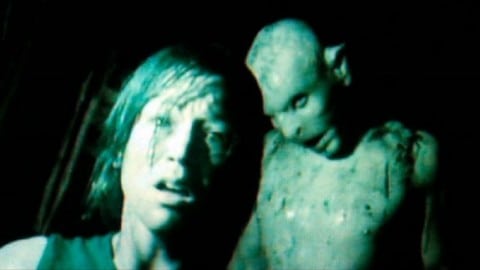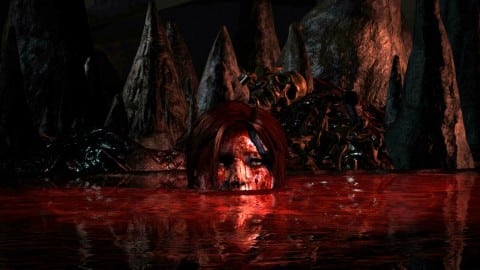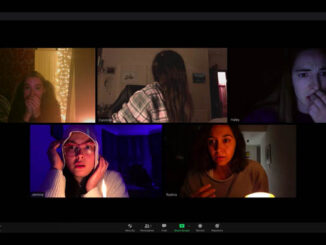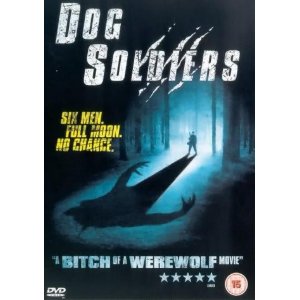The Descent (2005)
Directed by: Neil Marshall
Written by: Neil Marshall
Starring: Alex Reid, Natalie Mendoza, Saskia Mulder, Shauna Macdonald
HCF REWIND NO. 256: THE DESCENT [UK 2005]
AVAILABLE ON DVD
RUNNING TIME: 100 min
REVIEWED BY: Dr Lenera, Official HCF Critic
Sarah, Beth and Juno are rafting in Scotland. During the drive back to the hotel, Sarah’s husband is distracted and causes a collision, killing him and their daughter Jessica. One year later, Juno, Sarah, Beth and two other caving buddies are reunited at a cabin in the Appalachian Mountains of North Carolina, USA, along with Holly, a friend of Juno’s. The next morning the group goes caving. After a while, Juno admits that she has led them into an unknown cave system, instead of the fully explored cave system they planned for….
The Descent is a great example of how to wring the best from a simple premise. It’s a superbly intense experience that cleverly plays on fears many of us have, from claustrophobia to being alone in the dark, and there are some who say it’s better off without its monsters, the film’s more realistic first half being exciting and suspenseful enough, though I personally love the switch to a more fantastical mode, as if the writer/director is saying: “You think things are bad enough underground. Well, you ain’t seen nothing yet”. While it works best as a straight-forward, stripped-down exercise in jangling the viewer’s nerves, it does also contain interesting psychological aspects and even a bit of ambiguity as to whether the events you see on-screen are all happening, at least in the way that they seem. It also finds ways to make visually interesting what could seem ‘samey’ and dull. Frankly, I think it would be very hard to make a better film from the premise of The Descent, and it could very well be the best British horror film of the 2000’s in terms of the sheer visceral effect it has, and what it achieves with material which in the hands of others may not end up being that good at all.
Neil Marshall had just made the tongue-in-cheek werewolf actioner Dog Soldiers, and that was a reasonable success, but he avoided requests for a sequel. He’d already written a script called The Descent, but re-worked it so the explorers were all females. Though set in North America, the film’s exteriors were shot entirely in Scotland, and interior scenes were filmed in Pinewood Studios, where a maze of 21 cave sets was built. They often re-used the same areas as well as limiting lighting to the sources that the characters bring with them into the cave. The appearance of the ‘Crawlers’ was kept secret from the cast members until the first scene in which they encounter them was filmed. Of course the girls were genuinely scared and screamed the building down, running off set. The Descent was in competition with an American film of a similar premise, The Cave, which began filming six months before its competitor. Production of The Descent was therefore fast-tracked so it would come out before the other film. It was a solid success in the UK, but the US version lost a minute off the end so the film concluded in a somewhat happier fashion. This means that The Descent Part Two only makes sense if you’ve seen the American version. Considering Marshall wasn’t involved with it, one doesn’t really have to consider it a ‘legitimate’ sequel, and I certainly don’t, though that’s also because it isn’t very good and screws up many of the things that the original film did so well!
The Descent both takes its time and rushes into things, which I know sounds bizarre. It’s a while before we get into those caves, and over half way through when the Crawlers start attacking the cast members, but it also avoids going into the characters of our heroines too much and giving them issues, except for two of them, to deal with. The script just gives us enough for us to differentiate them from each other, then gets going. We first encounter Sarah, Beth and Juno on Scottish rapids [the actresses were actually doing it themselves too], having a whale of a time. Then Sarah has that car crash, which interestingly doesn’t rely on a loud crash noise to startle the viewer, that kills the other two members of her family. This is followed by a simple, but rather creepy, dream scene where she’s running down a corridor and blackness follows her. It unsettles, perhaps, because of its familiarity, rather than in spite of it. Then, we flash forward to a year later and a piss-up before setting off for the caves the next morning. However, there is also tension in the group, because Sarah still seems traumatised, and Juno regrets not having been there for her after her accident. In any case, these characters, through good writing and acting, convince as actual human beings.
Amidst the odd jump scare, the girls soon begin to descend into hell, and there’s a powerful feeling of dread already before someone gets stuck, their exit is blocked by a caving, and they have to get across a precipice in a truly edge-of-seat sequence. Sam McCurdy’s camera gets very close to the actresses so we can often see their breath, really enhancing the feeling of claustrophobia. We actually see brief glimpses of the Crawlers quite early on, but the first detailed view of one behind one of the girls, is a superb jump-out-your-chair moment. The scenes of the Crawlers attacking rely too much on ‘shakycam’ and fast-cutting, though that style is only employed for said scenes, and there’s plenty of truly uncomfortable suspense where the blind Crawlers can’t see their victims but can certainly hear them if they move. The sheer savagery of some of the gut-ripping, eye-gouging action is striking, and, while some have said that the Crawlers, influenced by not only Nosferatu but, it seems, by Gollum [in fact, come to think of it their hideous screeching noise is almost the same as that of the Nazgul] and the Morlocks from The Time Machine, are a bit too generic, but they serve their function well enough, and it’s nice that they remain a bit mysterious rather than the script finding ways to explain them away. Of course, they may not actually be real anyway. They may actually be just hallucinations of one of the characters, which gives the proceedings a deeper and, actually, more disturbing edge. Marshall doesn’t explicitly say this, but he gives subtle hints and allusions. If this is true, then what we are watching is a descent into insanity more than anything else.
Marshall packs his film with visual nods to movies as diverse as Alien, Vertigo, Carrie, Deliverance and Picnic At Hanging Rock, and I suppose some of them stick out if you recognise them, but each time I watch it I notice more [this time around, I recognised a pull out from a close-up of a screaming mouth a la The Bird With The Crystal Plumage], and I see it more as Marshall paying homage to films which have inspired him rather than showing off all the great films he loves. Of course, it helps that his own film, in terms of how it achieves what it sets out to do, is almost, if not quite, worthy of being included amongst such classics. Just consider the look of the film. Even before we go underground, a huge amount of effort has been made to visually differentiate different kinds of scenes, but when we do, McCurdy really shows lighting genius, such as the way caves are often bathed in different colours of light depending on the person’s torch. Even the really dark shots are carefully composed to have something interesting in them, like the way the helmet lights sometimes appear out of blackness to dance around on-screen. This film really is an object lesson in how to light something that could be visually monotonous and boring. Meanwhile David Julyan’s score, except for two ill-judged bits where he rips off Ennio Morricone’s The Thing, adds immensely to the atmosphere, often just content to eerily loom, half-noticed but getting into your head all the same, in the background.
The cast all play their roles well, and as for Marshall, a film-maker whose subsequent work has been decent but nowher near as strong as this film, this is easily his best work. It works so well that, even though I’ve seen it several times before, every time that girl seems to be getting out, as Julyan’s score becomes genuinely emotive and even uplifting, I find myself willing her to escape, and almost yelling at the screen. I want so much that happy ending which the Americans apparently wanted going by previews, and yet when the film was over I still realised it still had to end the way it did. So much of this film ‘gets’ me in a really uncomfortable way, like the simple bit when one of the girls is crawling through a tight space. Unlike in many similar scenes in other films where it’s just an actor crawling in a set, something about the way the scene is shot and staged makes it so convincing and really makes me feel cramped and hemmed-in. Whether it’s about monsters or not, this film knows what scares you, and then just goes ahead and does it.










Be the first to comment